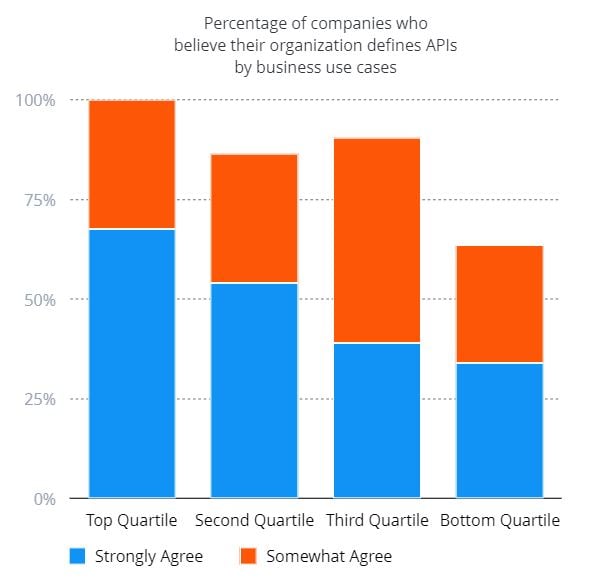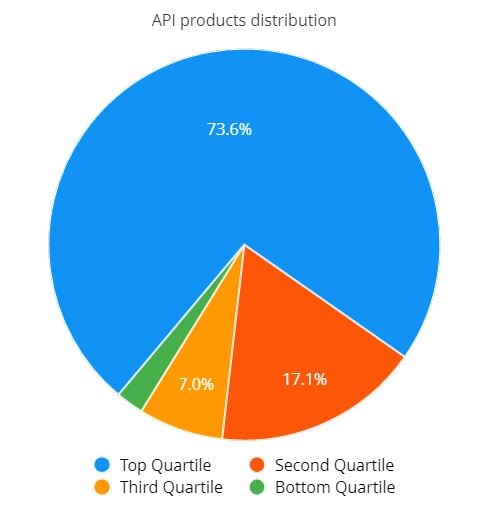Your organization has embarked on an API strategy perhaps, but is still pre-revenue with it. In fact, it doesn’t even look as if it will generate any significant revenue anytime soon. So while the intent to have an API business strategy was great, the implementation just hasn’t matched up.
That’s not us saying it like it is. It’s The State of APIs: 2017 Report: How APIs Power Digital Ecosystems, a report by Apigee based on “the hundreds of billions of API calls in the Apigee Cloud from hundreds of customers (in 2014-2016), as well as surveys conducted with customers across a variety of verticals.” That’s data we can get behind.
And what the data says is this: there is a clear and vast difference between the best performers (who have apps as well as API traffic) and the others. For example, the top quartile companies account for over 90% of the API traffic on Apigee Cloud. There’s something that the top quartile companies are doing, that other enterprises trying to execute their API strategy need to study. This report is about that. Here’s what they are doing right.
They look at two things: the business case; and the developers and partners. They obsess about the developers, and they focus on the business aspect as well.
Are APIs strategic to your business?
Yes, of course. Over 85% of the top quartile companies say Yes. But the others are not very far behind - close to 75% of the second quartile companies say Yes as well. And the third quartile are not lagging too much. So there’s a clear understanding among Apigee’s customer base largely, that “enterprises use APIs and API platforms to quickly deliver new apps while leveraging existing legacy services.”
Are you addressing the right business use cases?
If APIs are strategic to the business, it follows then that the stakeholders must be defining APIs to ensure the right business use cases. Right? Take a look.

Source: The State of APIs: 2017 Report: How APIs Power Digital Ecosystems
Well over 60% of the top quartile companies think they are defining APIs by business use cases. While the bottom quartile largely focuses on technical integration with APIs.
So enterprises need to explore how they will identify the business use cases to define APIs, what is priority and what can be part of the backlog. Here are some questions to ponder about:
-
How many takers are there for the API?
-
What volume of calls can be expected?
-
How many similar APIs exist?
-
What are our differentiators?
-
How easy is to communicate our value proposition?
Depending on what aspects are important to your business, more questions can emerge that will help you define the APIs. However, this means that there has to be serious intent from the strategic API team to get this ball rolling, and keep it going.
Are you treating APIs as products?
What does that mean? If you start treating APIs as products, you can package them, set up quota limits and have pricing models. You can iterate on these, and eventually have revenue goals.
The top quartile companies, as per the Apigee report, have four times more API products than organizations in the next quartile.

Do you have KPIs?
Do you have KPIs for the business success of your APIs? Have you defined what success means to your enterprise? What do you measure?
As it turns out, close to 60% of the top quartiles companies believe that the business success of the APIs is being measured. While in the next quartile it is in the region of about 30%. They measure metrics like direct or indirect revenue, and API consumption metrics like API traffic, the number of apps, and the number of active developers.
What’s the focus on digital ecosystem capabilities?
The report says that successful companies have platform initiatives that enable developers and partners, connect apps, and devices, and innovate on business models. Among the top quartile companies in the Apigee Cloud, the largest push in the digital ecosystem is to connect or enable partners. The suggests that focus is not so much on immediate monetization, but on creating far more leverage through partners. Take a look.
![]()
How good are you with developer development?
Companies must focus on the set of users who will drive the uptake of the APIs, the developers. That seems like a no-brainer. But the data shows something else. The top quartile enterprises attract the lion’s share of developers (96.2%). That’s because they focus on them. They have outreach programs like hackathons. They have developer portals that allow easy discovery of APIs, enable secure self-service modes of consumption enables by interactive documentation. They have developer communities to foster connections and exchange so the ecosystem grows.
It takes time and money. But isn’t that where the leverage is?
The State of APIs Report shares the best practices to enable your API business. How many of these are you doing well? And which ones do you need to work on?
The Leverage of Developer Portals
Srijan's API Management teams are equipped to implement your API strategy. If you already convinced about the need for an API-first strategy in place, and have a query on how to approach a developer portal, drop us a mail and we can get the conversation started.
Our Services
Customer Experience Management
- Content Management
- Marketing Automation
- Mobile Application Development
- Drupal Support and Maintanence
Enterprise Modernization, Platforms & Cloud
- Modernization Strategy
- API Management & Developer Portals
- Hybrid Cloud & Cloud Native Platforms
- Site Reliability Engineering




